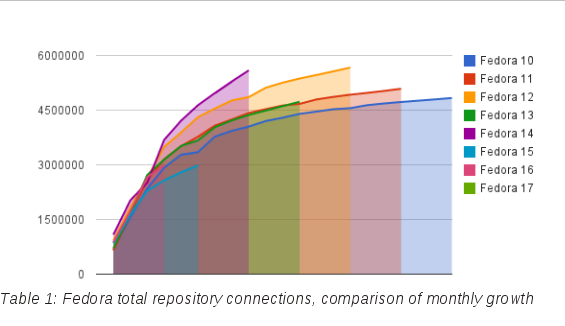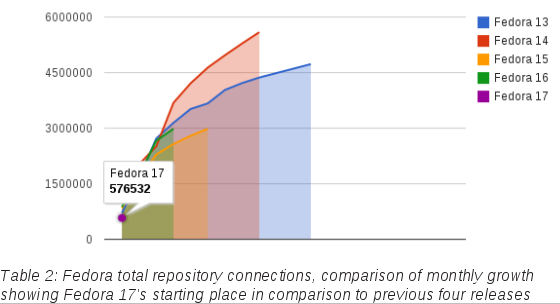Situational analysis and opportunities
Fedora intended user description
In 2009, the Fedora Board defined four characteristics that describe the minimum level of user for whom Fedora designs its default offering:
- Voluntary Linux consumer
- Computer-friendly
- Likely collaborator
- General productivity user
In this description, they also wrote, “We tend to favor consumers who are interested in taking a step toward collaboration.“ In other words, the best users are the next contributors.
Four Foundations
Fedora is built on a set values, its four foundations: freedom, friends, features, and first. But how successful have we been at each of those? Fedora as a whole is committed to freedom. FUDCon events in particular have become an excellent venue for promoting the friend value. But when it comes to features and first, we've been sliding.
User statistics
When comparing total connections to repositories, the most recent two releases have shown significant declines compared to their predecessors at the same points in their lifecycles:
However, when comparing yum connections week over week in the first six weeks after release, Fedora 17 does appear to be seeing significant increases over Fedora 16.
Unfortunately, user tracking is fraught with challenges, which should be recognized given its appeal as a measuring stick for our success. For example, a large university lab with many systems all running Fedora might appear to us as only one. Or someone with a Fedora laptop who connects from more than one network might appear to us as two or more.
Objectives and action plan
User survey
Fedora has never regularly conducted a basic study of its users. (There have been some attempts at market research.) We “survey” our community constantly by casual conversations and assumptions, but the first step in understanding their satisfaction and interests should be an annual State of Fedora study.
Brand standards
The Fedora brand is highly recognizable and one of our most valuable assets, and it should be protected as such. We have solid guidelines for the usage of the logo and appropriate colors, but that's about the end of it for brand standards or guidelines. We need a unified brand standards handbook on the wiki that: Expands graphically to better describe the Fedora “look.” Worldwide, our design style is scattered, and our materials don't look unified. Includes writing style guidelines. There's a style guide for the wiki and one for the Docs team, but not a unified style guide that can also be applied for marketing purposes. A shorter version for quick reference would also be helpful. (Why? Try asking three random people whether to capitalize the “p” in Fedora Project.)
Collateral
Collateral, the simplest tool in the marketing toolbox—and the most necessary. A robust list of common collateral is available, but many could use updating, and there's more we could be doing. For example:
Paper collateral
We should renew the print collateral we have available for handout at conferences and other events. If possible, each piece should also go through Transifex for translation into select languages. The [|brochures that address specific needs] (e.g., graphic designer, photographer, musician) are appealing and effective, but out-of-date and limited to artistic endeavors (they were originally created for SXSW where that was an appropriate choice). This line could be updated and expanded. We need at least one piece that is at an introductory, new-to-Linux level, as we do seem to encounter many such people, even at open source conferences!
T-shirts
It has become increasingly common to see a t-shirt marking each new release of a distro or other open source project. This could easily become a part of the cycle of Fedora releases and could help the community at large feel more invested in whatever is selected as the new method of naming releases. They also become a badge of honor for those involved over the long-term, i.e., when you can wear your release shirt from several years prior as evidence of the length of your interest and involvement. In addition, we should encourage printing shirts in women's cuts as well as the generic “unisex” styles, (which are anything but). For reference, the Fedora Design Team maintains a page with current and past t-shirt designs.
Laptop show
There is an existing [show”] intended for anyone who needs something to show on a screen at an event. However, it does not appear to have been updated since 2010. This should be a virtual extension of the event box and updated with each release.
Success stories
Most companies, including Red Hat, publish some version of “success stories.” Fedora has a list of possible “user stories,” (created in 2009) but most of them have never been written and some are out of date. Ideally these could be written as or in conjunction with getting-started guides so that they serve the dual purpose of displaying success as well as showing the reader how to duplicate said success.
Feature interviews
These interviews were once done after each release, but like other past practices noted here, have not been done in some time. Three or four features should be highlighted in interviews on the wiki, which could be republishable in other publications, and two of them should be done with audio, video, or screencasts.
Media outreach
We should in connection with this plan have a media relations plan for increasing coverage of Fedora in relevant publications. We can help connect Fedora technical gurus with the appropriate publications for creating more in-depth pieces. This media relations plan should begin with updating the, which should include:
- A simple backgrounder and facts one-sheet
- A consolidated repository for Fedora videos
- An experts list
- Press coverage archive
- Media request form
See also: http://fedoraproject.org/wiki/Fedora_press_material


